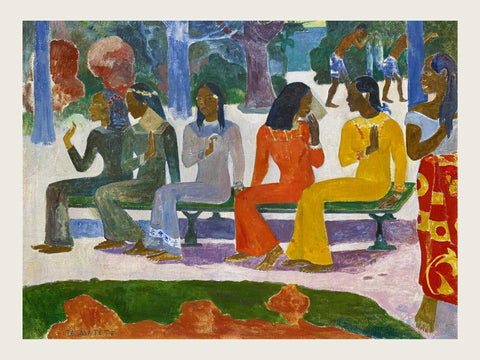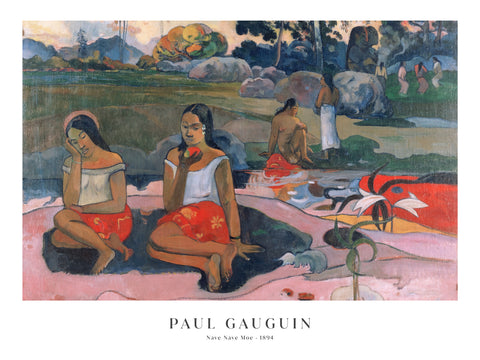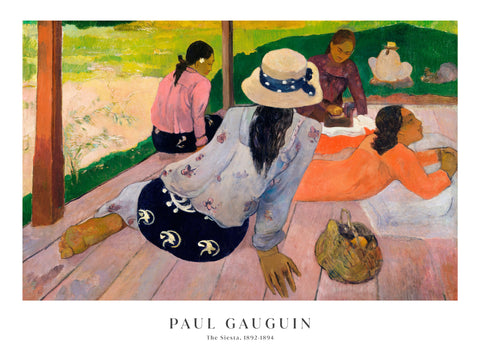7 Most Famous Paintings by Paul Gauguin
Introduction
Paul Gauguin is one of the most famous painters in history, and for good reason. His paintings are some of the most recognizable in art history, from Tahitian Landscape to his iconic self-portraits. Although Gauguin has a reputation as an outsider artist and is often overlooked by modern audiences, his work is truly worth taking a look at. In this article we'll explore seven of his most famous paintings, along with some context about their creation and significance:
1. Tahitian Landscape - 1891
The painting is a landscape with a tahitian island in the background. The colors are vibrant and the shapes are simple, but the painting does not have realistic detail. The perspective of this work appears flat because there is no indication of height or depth in relation to the viewer; however, Gauguin did use some shading techniques such as lights and darks to give more detail to his artwork.
2. Arearea - 1892
Arearea, by Paul Gauguin, is one of the most famous paintings in all of French art. The picture depicts a Tahitian woman standing naked in a grassy meadow. She wears flowers in her hair and on her neck, and her pose is relaxed yet seductive.
The painting has been exhibited in museums around the world, including at the 1893 World's Columbian Exposition in Chicago (where it won first prize) and at the 1901 Pan-American Exposition held in Buffalo, New York. Both exhibitions attracted crowds eager to see this work firsthand and experience its beauty for themselves; over time it has become one of Gauguin's most widely known works as well as an icon of French Impressionism.
This wasn't always so: at first glance Arearea looks like nothing more than a portrait painted outdoors—but once viewers take a closer look they notice something strange about the way each flower seems almost alive with vibrant color; how each blade of grass glows with vibrant green against brown earth; how every detail seems carefully placed just where it needs to be; how everything together comes together into what can only be called magic!
3. We Shall Not Go To Market Today - 1892
The painting is one of the most famous in Gauguin's oeuvre and has been called a masterpiece and a masterpiece of modern art. It was sold for $300 million in 2015, making it the most expensive painting ever sold at auction.
The painting depicts an old woman who appears to be preparing to sell her wares at market, but she has not yet arrived at the market or even left home. The work may have been inspired by Gauguin's trip to Tahiti when he met his wife-to-be Andrée Hesselinger and traveled with her along the South Pacific islands. Or perhaps it was inspired by stories he heard from local villagers about how they would go into town once every two weeks or so—a long journey away—to sell their produce and other goods there.
4. The Painter Of Sunflowers - 1888
The Painter of Sunflowers is one of the most famous paintings in the world. It was completed by Paul Gauguin in 1888, and it is an example of Post-Impressionism. The painting depicts a sunflower field at Asnières, on the outskirts of Paris. The painting has a strong connection to van Gogh's work: Gauguin was strongly influenced by van Gogh's style when he painted this piece, which shows his feelings on modern art from his viewpoint as an outsider artist with no formal training.[1]
The painting reflects Gauguin's interest in using color for expressive purposes rather than realistic depiction, as well as his interests in Japanese woodblock prints and Japonisme (the influence of Japanese culture).[2]
5. Still Life With Head-Shaped Vase And Japanese Woodcut
While the vase is a head-shaped vase and the woodcut is Japanese, neither of these elements are essential to this painting’s meaning. In fact, most art historians believe that Gauguin deliberately left out any additional information or explanation in order to create a piece with deeper meaning. The title itself suggests nature and life—two things we associate with living things like flowers and trees. This painting shows us how even something as simple as an empty vase can represent something beautiful just by existing on its own terms without needing any further explanation from us as viewers.
6. Nave Nave Moe - 1894
This painting is a portrait of a Tahitian girl named Teha’amana. The shape of the face and contours of her features are painted with strong contrasts between light and dark values, which seems to be characteristic of Gauguin's Synthetist style. Nave Nave Moe also includes a background pattern that is reminiscent of Japanese woodblock prints. This piece was one of Gauguin's first impressionist paintings, executed in 1894 at Pont-Aven in Brittany, France. It was sold for more than $50 million in 2010 to an anonymous buyer at Christie's auction house in New York City
7. The Siesta - 1892
In 1892, Paul Gauguin traveled to Tahiti in search of what he called "the primitive." There, he painted a series of works depicting island life. One of them—The Siesta—was his first painting to be sold at auction. It was purchased by the Metropolitan Museum of Art for $300,000 in 1990 and currently hangs in their collection.
A portrait of a Tahitian woman resting on the beach, The Siesta is an example of Impressionism at its peak: Gauguin shows us his subject's silhouette against a lush green background without any other detail or distraction. The resulting composition has both softness and strength; it blends nicely with the viewer's imagination while maintaining focus on its subject's pose.
Gauguin's paintings are some of the most famous in art history.
Gauguin's paintings are some of the most famous in art history. He was a French post-impressionist painter who worked in Brittany, France, Tahiti and Martinique before settling in Punaauia on the Marquesas Islands. His paintings are known for their bold colors, exotic subject matter and flat surfaces.
Gauguin is best known for his painting "Where Do We Come From? What Are We? Where Are We Going?" which depicts three Tahitian women wearing traditional costumes on a beach with palm trees behind them. The painting was purchased by Charles Deering (1862-1945) while he was visiting Tahiti with his wife Mary Lily Munroe Deering (1844-1914). The couple toured Polynesia aboard their yacht Oloma II during 1888-89 before returning to their home in Miami Beach where they displayed it prominently at their residence until 1928 when they donated it to the Art Institute of Chicago where it remains today as an iconic piece representing Gaugin’s legacy both artistically and culturally.
Conclusion
Gauguin is one of the most famous artists in history, and his paintings are some of the most famous in art history. His work was revolutionary for its time because it broke with traditional forms and moved towards a more expressive style. He used colors that weren't usually seen in European art at that time, such as yellows and browns instead of blues or reds. His paintings also had strong outlines around their subjects which gave them a distinct look compared to other paintings at this time period (like those by Vincent Van Gogh). This allowed Gauguin's work to stand out amongst others'.















